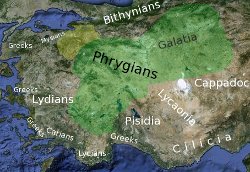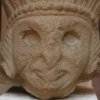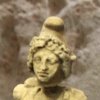The Phrygians and the Phrygian language
The Phrygians and their language
The term “Phrygian” is usually not widely known to people or it does only ring a bell. Some recognize it as a mode in music or a cap that became popular around the 18th century. Not even the greatest Phrygian King, Midas, is remembered with that ethnonym. Despite they seem to have faded away in time, Phrygians were a prosperous nation that established a great Kingdom during the Iron age in Anatolia (nowadays Turkey). Were they the oldest nation ever? The Egyptians believed so! Herodotus tells us that Pharaoh Psammeticus wanted to find out what the first language of the world was. He gave two babies to a shepherd and told him that no one should speak to them, but that he should take care of them while listening to determine their first words. The hypothesis was that the first word they would say would be in the root language of all people. When the children cried “bekos” the shepherd concluded that the word was Phrygian because that was the sound of Phrygian word for “bread”. Thus, they concluded that the Phrygians were an older people than the Egyptians, and that Phrygian was the original language of men. In Greek sources they first appear in Homers Iliad, who mentions them as the allies of the Trojans that came from Ascania (Bithynia). In the beginning of the 7th century BC, Phrygia suffers from the Cimmerian invasion and by the end of the same century it falls under Lydian rule. They keep always close contact with the Greeks and continue to live on as a nation within nations.Origins of the Phrygians
 Phrygians, were not natives in Anatolia. After the tragic end of the Hittite empire, the vacuum that was created allowed many people from the Balkans to move in. The Phrygians made themselves supreme and established a kingdom standing on the remains of the Hittites. Their migration must have started around 1200 BC and continued in waves for a long period. By the 8th century BC they emerge as a strong political entity and their King Midas is mentioned in the Assyrian records as King of the Mushki. The term Mushki is however misleading, since later the Greeks make a clear distinction between the Moschoi ( equal to Assyrian Mushki) and the Phrygians. Based on a Macedonian account, Herodotus tells us that the Phrygians were called Briges (probably derived from IE bhereĝh- 'high, mountain') as long as they dwelt in Europe, where they were neighbours of the Macedonians, near mount Bermion; but when they moved to Asia, they changed their name. It is probable that the name Phryges is what reached to us today through Greeks and that early, pre-Anatolian Phrygians actually called themselves Briges or Bryges. There is currently archaeological evidence to support such a scenario. Apart from the ancient accounts and archeology, the numerous isoglosses between Greek and Phrygian presuppose a close genetic relationship in prehistoric times (see Brixhe 1994:176-77). The two languages must have been in close contact until the end of the second millennium BC and it seems that the proto-Indo-European ancestors of the Phrygians, Greeks and Armenians entered the Balkans during the early bronze age. After the migration to Anatolia, Phrygians came in contact with the Anatolian populations who affected them in several ways. Religiously they adopted the pre-Indo-European cult of the Great Mother Cybele/Rhea, which they were calling Matar Kybileya. Culture and art was affected from the few remaining Hittites and later the Lydians. The relation of the Phrygians to the Armenians remains uncertain, not in the sense that they are not related at all, but in way they are related. In ancient sources, Armenians are described as Phrygian colonists. However, under the influence of Hurro-Urartean and Luwian, Armenian changed considerably. There's obviously a common prehistoric language relationship but there's no way to estimate when and how the two languages diverged from each other. On the question whether Phrygians retained a sense of Ethnic identity, C. Brixhe supports the idea that they actually did, even when they had been under foreign rule. We can't know exactly when their identity faded away, but it is believed that Phrygian was hardly spoken until the 7th century AD, when it was finally replaced by common Greek. That should let their ethnic identity to live on for some short time ahead.
Phrygians, were not natives in Anatolia. After the tragic end of the Hittite empire, the vacuum that was created allowed many people from the Balkans to move in. The Phrygians made themselves supreme and established a kingdom standing on the remains of the Hittites. Their migration must have started around 1200 BC and continued in waves for a long period. By the 8th century BC they emerge as a strong political entity and their King Midas is mentioned in the Assyrian records as King of the Mushki. The term Mushki is however misleading, since later the Greeks make a clear distinction between the Moschoi ( equal to Assyrian Mushki) and the Phrygians. Based on a Macedonian account, Herodotus tells us that the Phrygians were called Briges (probably derived from IE bhereĝh- 'high, mountain') as long as they dwelt in Europe, where they were neighbours of the Macedonians, near mount Bermion; but when they moved to Asia, they changed their name. It is probable that the name Phryges is what reached to us today through Greeks and that early, pre-Anatolian Phrygians actually called themselves Briges or Bryges. There is currently archaeological evidence to support such a scenario. Apart from the ancient accounts and archeology, the numerous isoglosses between Greek and Phrygian presuppose a close genetic relationship in prehistoric times (see Brixhe 1994:176-77). The two languages must have been in close contact until the end of the second millennium BC and it seems that the proto-Indo-European ancestors of the Phrygians, Greeks and Armenians entered the Balkans during the early bronze age. After the migration to Anatolia, Phrygians came in contact with the Anatolian populations who affected them in several ways. Religiously they adopted the pre-Indo-European cult of the Great Mother Cybele/Rhea, which they were calling Matar Kybileya. Culture and art was affected from the few remaining Hittites and later the Lydians. The relation of the Phrygians to the Armenians remains uncertain, not in the sense that they are not related at all, but in way they are related. In ancient sources, Armenians are described as Phrygian colonists. However, under the influence of Hurro-Urartean and Luwian, Armenian changed considerably. There's obviously a common prehistoric language relationship but there's no way to estimate when and how the two languages diverged from each other. On the question whether Phrygians retained a sense of Ethnic identity, C. Brixhe supports the idea that they actually did, even when they had been under foreign rule. We can't know exactly when their identity faded away, but it is believed that Phrygian was hardly spoken until the 7th century AD, when it was finally replaced by common Greek. That should let their ethnic identity to live on for some short time ahead.
The Phrygian language
Phrygian is one of the oldest and least attested Indo-European languages. It is far from being completely understood and decipherment is still in progress. Unlike other poorly attested languages, Phrygian has written records in the Phrygian and later the Greek alphabet. Despite their number, those are often repetitive curses and do not add much to the Phrygian vocabulary. Thankfully though, the language’s grammatical and lexical similarities to Greek makes it possible to gain valuable information from the texts even when they cannot be deciphered fully.Dating of Phrygian
The earliest records of Phrygian, called Palaeo-Phrygian, are almost as old as Greek alphabetic writing and appear as early as the 8th century BC. They are found over a vast area within Anatolia, even in areas where Phrygian presence was not certain. A complete absence of native writing follows for centuries, with the exception of one inscription written in the Attic Greek alphabet from the 4th century BC. The context of this particular text is often referred as Middle Phrygian. The neo-Phrygian inscriptions date from the 1st century AD until the mid 3rd century.Classification
In the past there was a debate about the position of Phrygian (centum versus satem) within the Indo-European languages. There were thoughts about a Thraco-Phrygian grouping. Thraco-Dacian (or Thracian and Daco-Mysian) seems to belong to the eastern (satem) group of Indo-European languages and its (their) phonetic system is far less conservative than that of Phrygian (see Brixhe and Panayotou 1994, §§3ff.). However, when the Phrygians, in about the second half of the second millennium B.C, passed gradually over southern Thrace into the north-western part of Asia Minor, their language was slightly influenced by Thracian (see Vladimir Georgiev, The Slavonic and East European Review - The Genesis of the Balkan Peoples, University College London 1966, pp 289). Generally it is agreed, that Phrygian, belongs to the centum group of Indo-European. It has been influenced by the Anatolian IE languages, sharing several isoglosses like the -s ending for the third-person singular of the preterite verb and the single endings for names of both men and women. Also there are several similarities with Latin, such as the use of the preposition-preverb ad(-), the extension of the infix -k- to the present stem (e.g Phrygian “addaket” compared with Latin “afficiat”) and the ending -tor of the middle third-person singular (Latin -tur). However, as Ancient Greeks had already noticed, from all languages, Phrygian shares most of its features with Greek, which is regarded its closest relative.Non-exclusive isoglosses include:
- the relative pronoun yos/ios/ιος
- the augment (used for forming past tense e.g “eberet, edaes”)
- The proclitic e-
- the stem pant- “all”
Exclusive isoglosses include:
- the -s ending of the nominative singular of a-stem masculine nouns.
- the denominative verbs in ∗-ye/o- built on o-stems (Greek κακόω “I mistreat”, Paleo-Phrygian kakoioi/kakuioi)
- the participial suffix -meno-
- the pronoun auto-
- the stem kako-
- the conjunction αι, having the same conditional usage as Doric and Aeolic αι.
These features betray very close prehistoric ties between the two languages, Phrygian and Greek, as well as the fact that they belong, no doubt, to the same dialectal subgroup of early Indo-European (Greco-Phrygian?). The odds are that Midas titulature in inscription M-01a, “Midai lawagtaei wanaktei” - ' Midas leader (of the people) and king', where appear two functions that are also found in the Mycenaean Greek documents (lawagetas and wanax), does not correspond to Greek borrowings, but rather reflects the existence of a common heritage.
Characteristics
- The voiceless stops of Proto-Indo-European – ∗p, ∗t, and ∗k/∗kw, developed into /p/, /t/,/k/ and the voiceless affricate /ts/.
- The Proto-Indo-European plain voiced stops ∗d, ∗g and the voiced aspirates ∗bh, ∗dh, ∗gh developed into voiced stops /b/, /d/, /g/.
- The Proto-Indo-European initial *s- is lost in the initial cluster *sw-.
- The voiceless affricate /ts/ (?), written ↑, developed from ∗k occurring before the front vowels /i/ and /e/, and is probably matched by a voiced /dz/ which arose from ∗g and ∗gh in the same context
- The Proto-Indo-European *ē turned to ā.
- The Proto-Indo-European *ō turned to u.
- The Proto-Indo-European syllabic liquids and nasals undergone similar development to that in Greek.
You can see the complete list of the sound changes from PIE to Phrygian here.
Sample Glossary
Below are some selected words that demonstrate the similarity of several Phrygian words to words of other Indo-European languages.| Phrygian | Meaning | Comments |
|---|---|---|
| ad- | to, by, at | Latin “ad-”, Umbrian “ap-”, English “at” |
| azena | beard | Greek “geni”, Latin “gena”, Welsh “gen” (cheek, chin) |
| bekos | bread | Cypr. Greek “bekos”, Greek “phogo” (to roast) and later “bukia” (mouth full), Albanian “buka” , English “baker” |
| ber- | to bear, carry | Armenian “berem”, Greek “pher-”, O.Ir. “biru”, O. Ind “bhárati” |
| brater | brother | Greek “phrater”, Latin “frater”, Lithuanian “brolis”, Old Icel. “brodir” |
| breit | break, crack | English “break” |
| ezis | hedgehog | Latvian “ezis”, Lithuanian “ezys”,Greek “ echinos” |
| gordion | town | Old Ind. “grdha” (house, dwelling), old Eng. “gyrdan” (gird), Old Church Slav. “grad” (castle, town), Greek χόρτος & tn Γορτυνία |
| knaika | woman, wife | Greek “gynaika”, Armenian “kin”, Lydian “kana” |
| matar | mother | Old Ind. “matar”, Greek “mater”, Armenian “mayr”, Latin “mater”, Old Ir. “mathir” |
| onoman | name | Greek “onoma”, Latin “nomen”, Armenian “anown”, Umbrian “nome” |
| pinke | five | Greek “pente”, Old Ind “panca” Latin “quinque”, Lithuanian “penki”. |
| pour | for | French “pour”, Italian “per” |
| zamelos | human being, mortal | Greek “chamelos” (low, near to the ground), Slav. “zemlja”, Old Ind. “ksam-” |
What were the Phrygians writing?
Most probably, Phrygians produced all kind of texts in their time. Unfortunately only rock cuts, seals and graffito survived. Amongst these we find: cult texts, royal affirmation of suzerainty, curse formulas, marks of ownership and perhaps notations of gift exchange. Below you will find some sample sentences in Phrygian:Phrygian: Βας ιοι βεκος μεβερετ - Bas ioi bekos meberet
English: Bas will take his bread away.
Phrygian: Aυτος κε ουα κ' οροκα γεγαριτμενος ας Βαταν τευτους - Autos ke oua k' oroka gegaritmenos as Batan teutos
English: and may he himself and his progeny become cursed by Bas
Phrygian: Ιος σας του σκερεδριας κακουν δακετ, ετιτετικμενος Αττιε ειτου - Ios sas tou skeredrias kakoun daket, etitetikmenos Attie eitou
English: Whoever brings damage to this ossuarry/skeleton of him, let him be damned by Attis
Phrygian: Ατες ΑρκιεFαις ακενανογαFος Μιδαι λαFαγταει Fανακτει εδαες - Ates Arkiewais akenanogawos Midae lawagtaei wanaktei edaes
Ancient Greek: Άτες Αρκιάδης ακενανόγαFος Μίδα λαFαγέτη (F)άνακτι έθηκεν.
English (direct): Ates of Arkias, the akenanogawos (title), to Midas, leader of the people and King, dedicated.
Plain English: Ates, son of Arkias,the akenanogawos(title) dedicated this to Midas, leader of the people and king.
Greek & Phrygian hybrid sentence
ὃς ἂν τούτω / τῶ / μνημείω / κακῶς προσποιήσει . . . , με δεως κε ζεμελως κε τι τετικμενος ειτου.
Whoever damages this monument . . ., will be cursed amongst/by gods and men.
The longest Phrygian text is that from Vezirhan/Germanos in Bithynia.
sin t'imenan kaliya‹s› ti(:)tedat[.....]e[.]ekmo[.]menan[.]a
iben edatoy dakeran atriyas(:)dawoi wrekan akiwan
wrekan witaran artimitos kraniya-p[...]
panta webras adun(:)pos-key estat pator-p ike[......]an dati
way niptiyay daker karatu [.]enpsatus.meka as-k‹e›y
nidus [.]a(:)kaliyay karatu panato ando-p opostois klaniw
kelmis-ke umnis etewradus dakerais-key iwerais
atikwaiu yos-niy(:)art sin-t imenan kaka oskawos kakey
kan dedapitiy tubeti(:)woynewos deragiw mekas-key
kowis abretoy(:)nun ibeyn erotan niptiyan girun mireyun
iwimun inmeney asenan daket torwetun ↑.irayay(:)niyoy
tubnuw newos mederitoy koris-ke abretoy(:)nun oynew
yos(:)isekos.os ↑emeney pupratoy weban ituw
The inscription is not fully understood, but in short, it informs us that Kallyas, son of Abiktos, dedicated a sanctuary to the Great Mother. Kallyas hoped that whoever harmed the sanctuary would be deprived of life and progeny, and he wished happiness to those who came and read his inscription.
Gauls in Phrygia
During the 3rd century BC, a group of Gauls settled amongst the Phrygians in Anatolia. Those Celtic speaking people became known as Galatians to the locals. Their ruling class becomes quickly Hellenized and do not contribute linguistically to the Phrygian language, apart from the personal name “Bodoris” and the lexeme “teutous”.Phrygian Greek
If we have to choose a region where a non-Greek language had most impact on Koine Greek, that would be no doubt Phrygia. The local Phrygian aristocracy certainly spoke and wrote in the same standard language as elsewhere, as shows in the public documents, but in texts from the private sphere we can observe much interference with the local language in addition to the phonetic feature just mentioned. Some remarkable cases include:- Metathesis of r and l, particularly frequently in Phrygian, e.g., Οὐαρελιανόν for Valerianum
- reduction of st to t word-internally or word-initially, e.g., ἀνέτησα or εἰ (= εἰς) τὸν ϑεόν
- replacement of t in some cases with th- e.g θέκνοσι (note also the neo-Phrygian dative plural ending -ωσι) instead of τέκνοις, τιγατρί instead of θυγατρί, κατέσθησεν instead of κατέστησεν
- alternations of spelling between κ and χ ( e.g κάριν μνης), π and φ.
- prothesis, relatively rare in Asia Minor, but particularly abundant in Phrygia and in the adjacent areas, e.g. ἰστήλην, ἰσπουδασάντων
- substitution of πος/ποσ- for πρός/προσ-, no doubt because of the existence in Phrygian of a preposition/preverb πος/ποσ- which was functionally identical, e.g. ποστείμου, ποσάξει, πός (SW. Phryg.), ποσαμάρτη (Lyd., a zone with a partially Phrygian population)
- adoption of vocabulary of Phrygian origin: τὸ βέννος “association of faithful”, ὁ βέκος “bread” and ὁ δοῦμος “religious association.”
However, the most characteristic feature of modern Greek seen in this area is the replacement/confusion of dative with genitive. The question that arises is if this Phrygian Greek idiom is a separate dialect from the standard Greek spoken in the surrounding areas? If that is the case, that dialect would be one of the first modern Greek dialects born from the diversification of the Koine. Unfortunately, as C. Brixhe ( 1987a: 110–16, 158; 2002: 259–63) says, the Arab incursions of the 7th century AD didn't let it develop in order to make it until the treaty of Lausanne (1923).
The periods of Graeco-Phrygian contact
As mentioned earlier, Phrygian and Greek had close contacts. Those contacts can be divided into three periods (Tzitzilis 2012):- The period of Balkan coexistence.
- The first Asia Minor period from the Phrygian arrival to the conquest of Phrygia by Alexander the Great.
- The second Asia Minor period, from Alexander to their final assimilation.
During the Balkan period, the contact between proto-Phrygian and proto-Greek occurs. Before the Phrygian migration to Asia Minor, a possible effect of Phrygian on the ancient Macedonian dialect of Greek has to be considered.
Quotes about the Phrygians
Herodotus( Book II, Euterpe): Since Psammetichus, however, made an attempt to discover who were actually the primitive race, they have been of opinion that while they surpass all other nations, the Phrygians surpass them in antiquity.Herodotus( Book VII, Polymnia): According to the Macedonian account, the Phrygians, during the time that they had their abode in Europe and dwelt with them in Macedonia, bore the name of Brygians; but on their removal to Asia they changed their designation at the same time with their dwelling-place. The Armenians, who are Phrygian colonists, were armed in the Phrygian fashion. Both nations were under the command of Artochmes, who was married to one of the daughters of Darius.
Strabo(Geography): Bordering on the Bithynians towards the south, as I have said, are the Mysians and Phrygians who live round the Mysian Olympus, as it is called. And each of these tribes is divided into two parts. For one part of Phrygia is called Greater Phrygia, the part over which Midas reigned, a part of which was occupied by the Galatians, whereas the other is called Lesser Phrygia, that on the Hellespont and round Olympus, I mean Phrygia Epictetus, as it is called.
Plato(Cratilus - while Socrates speaking to Hermogenes): Well then, consider whether this pur is not foreign ; for the word is not easily brought into relation with the Hellenic tongue, and the Phrygians may be observed to have the same word slightly changed, just as they have udor (water) and kunes (dogs), and many other words.
Gallery






Sources
-
J. Boardman, I.E.S Edwards, N.G.L Hammond, E. Sollberger - The Cambridge Ancient History III, part I ,
'
The Prehistory of the Balkans and the Middle East and the Aegean world, tenth to eighth
centuries B.C
', Cambridge University Press 1982
-
C. Brixhe on Phrygian in Roger D. Woodard's - 'The ancient languages of Asia Minor', Cambridge University Press 2008
- J. P. Mallory, Douglas Q. Adams - 'Encyclopedia of Indo-European culture', 1997
-
David W Antony - 'The horse, the wheel and language', Princeton University press, 2007
- C. Brixhe 'Le phrygien in langues indo-europeennes', 1994
-
C. Brixhe's 'Greek and Phrygian' on A.P Christides, M. Arapopoulou - '
A history of ancient Greek: from the beginnings to late antiquity', Cambridge
University Press, 200
-
C. Brixhe's section '
Interactions between Greek and Phrygian' in J. N. Adams, M. Janse, S. Swain -
'Bilingualism in ancient society: language contact and the written word', Oxford
University Press, 2002.
- Vladimir Georgiev , 'The Slavonic and East European Review - The Genesis of the Balkan Peoples', University College London 1966
-
Georges Perrot, Charles Chipiez - 'History of Art in Phrygia, Lydia, Caria and Lycia', London 1892
-
Lynn E. Roller - 'In search of god the mother : the cult of Anatolian Cybele', University of
California Press, 1999
Tags: Phrygian language, Phrygia, Phrygians, Graeco-Phrygian, Armenian, Cybele, Midas, Attis, Anatolia, Asia Minor, Greece, Turkey, Balkans, Macedon, Μακεδονία, Edessa, Bermion, Bekos, Bread, Thracian, ΤΟΤΟΣ